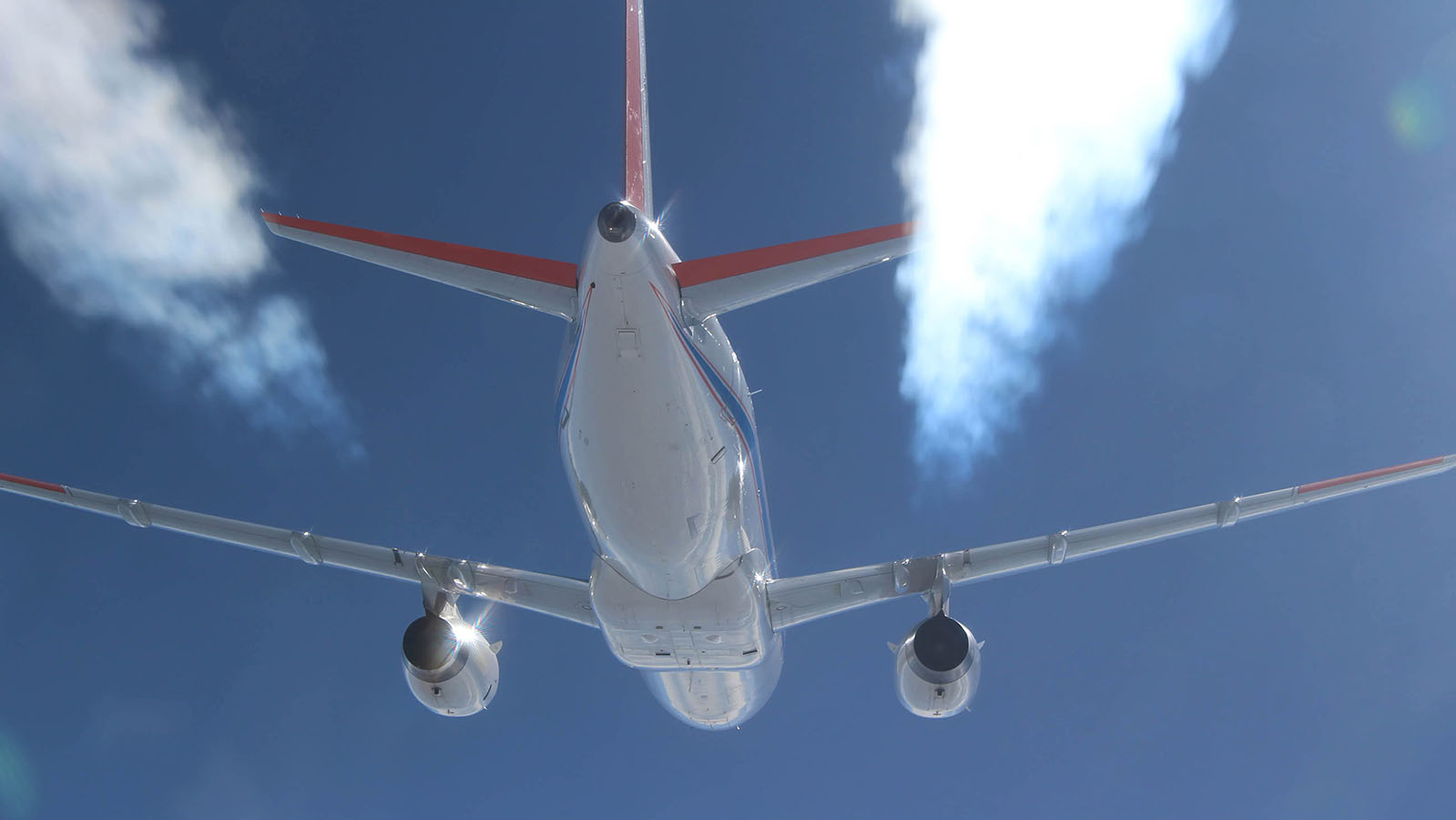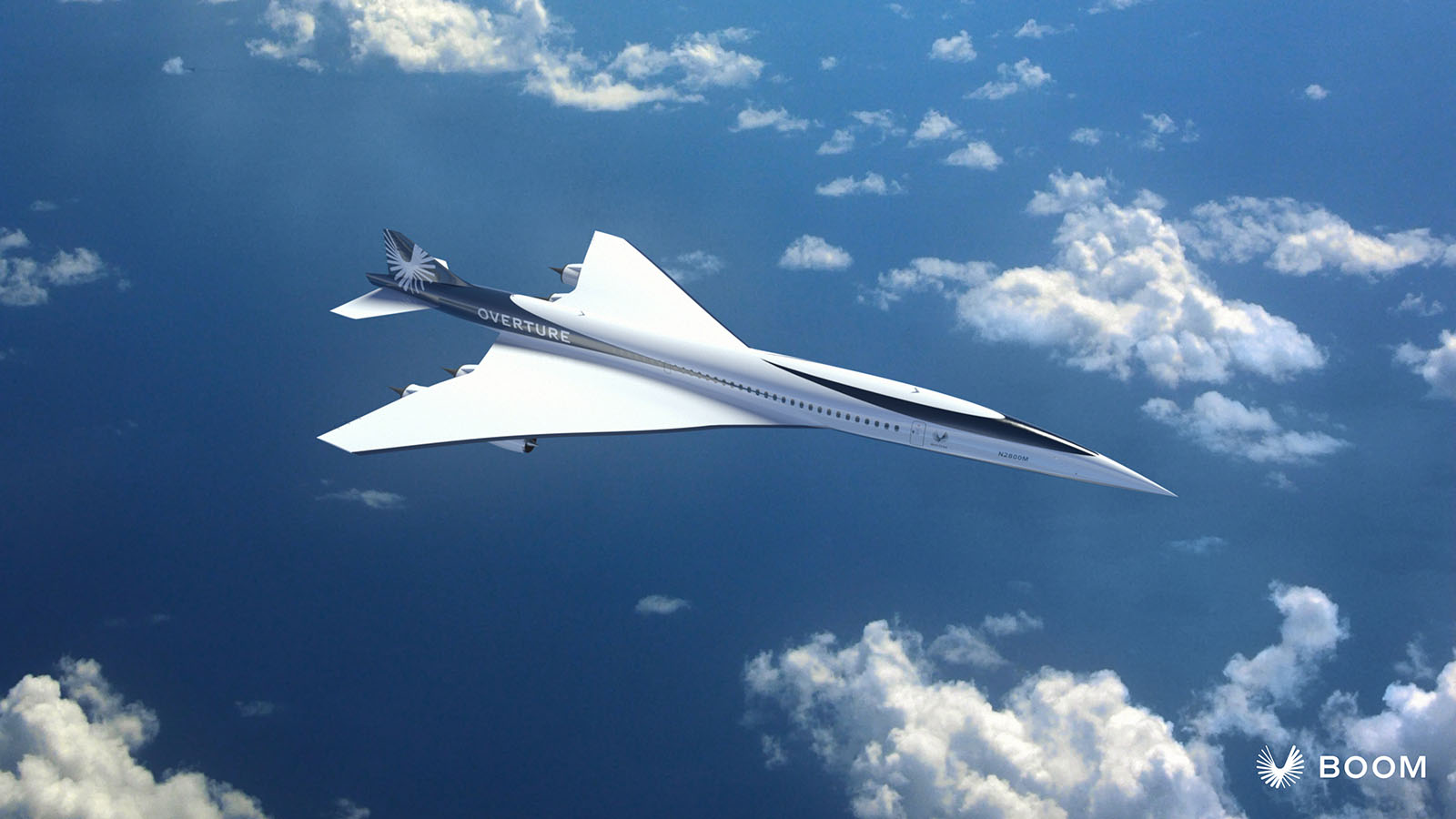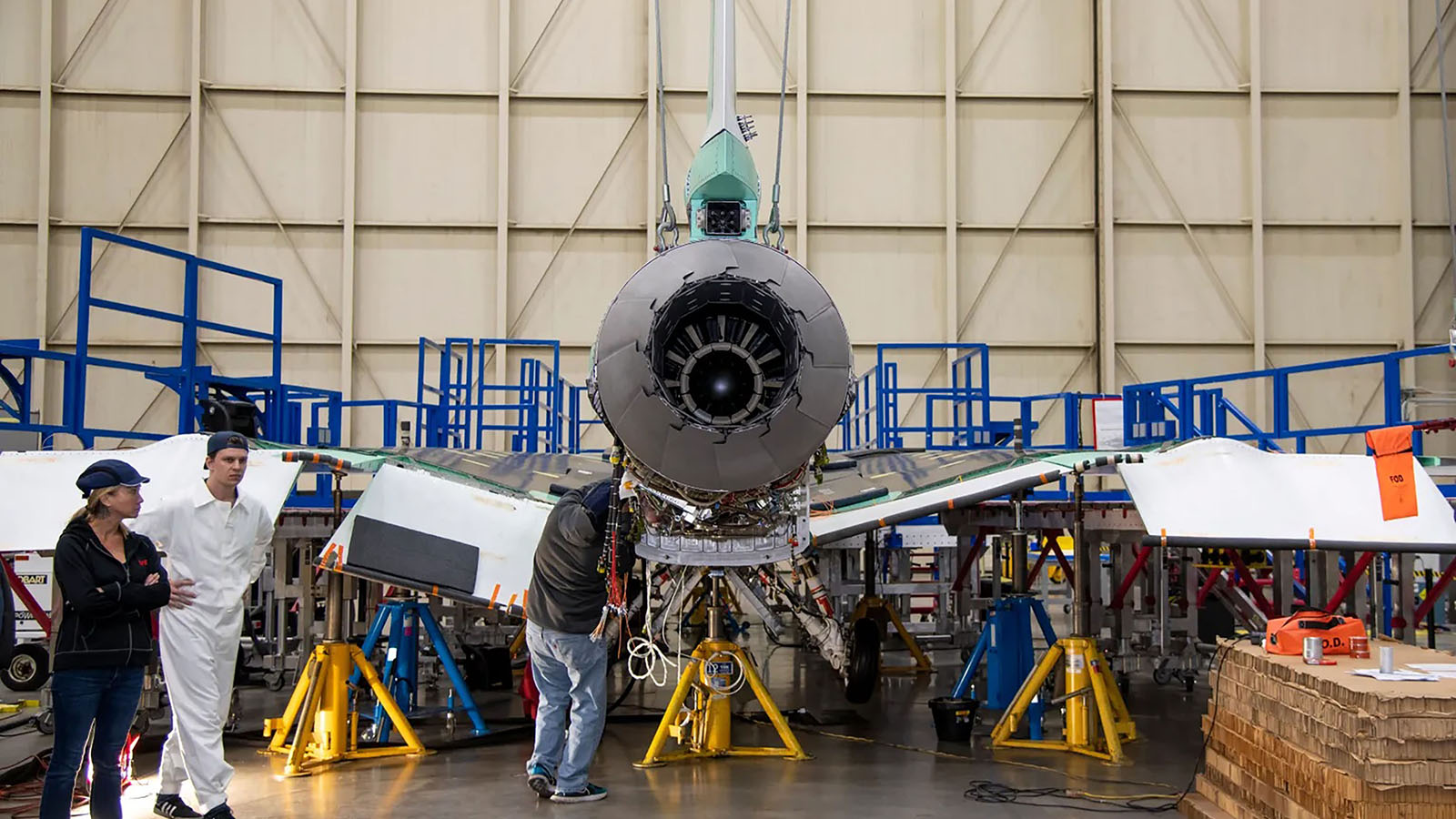Stay Up to Date
Submit your email address to receive the latest industry and Aerospace America news.
Aerospace engineers want to help us all get where we’re going faster — possibly at supersonic speeds. Many also care deeply about environmental sustainability. Can this conflict be resolved? Keith Button looks at the science.
MIT scientists had spent five years preparing computer models of the global atmosphere and of notional supersonic passenger plane fleets and routes. Now, in 2019, they were finally ready to run their first simulation of how the emissions produced by these aircraft over decades of flights would affect the atmosphere.
The simulation was so complex that it was expected to take about a month for the cluster of high-performance computers at MIT’s Laboratory for Aviation and the Environment in Cambridge, Massachusetts to churn out the results. Research scientist Sebastian Eastham logged into the lab’s network every day to monitor the progress. When the results finally appeared on his screen, he was disappointed but not surprised: The models showed that a resurgence in supersonic passenger flight would damage Earth’s ozone layer and contribute to climate warming.
“At some level, it was honestly what we expected, and that was a mixed feeling,” says Eastham, an aeronautical engineer who is now a senior lecturer in sustainable aviation at Imperial College London’s department of aeronautics. “There was a little spark of disappointment that there wasn’t a clean solution that we could see.”
Eastham’s MIT group went on to run about 10 of these global simulations, after hundreds of smaller simulations to develop and test its models, all under a NASA-sponsored research project. In 2022, the group published its analysis, “Impacts of a near-future supersonic aircraft fleet on atmospheric composition and climate.” The conclusions matched those of other atmospheric modelers over the past few years: Supersonic flight would lead to ozone depletion in the stratosphere, primarily due to nitrogen oxides, NOx, produced during combustion. Loss of ozone at that altitude would allow more ultraviolet radiation to reach the surface, raising the risks of skin cancer, cataracts and immune suppression. The NOx would also create ozone at lower altitudes, where it would be an air quality hazard and absorb radiation from Earth’s surface, preventing heat from escaping into space.
The projected impacts have prompted second-guessing about flight research priorities in some corners of aerospace, just as the industry is on the verge of solving the main problem that plagued the Concorde generation of supersonic travel: ear-splitting sonic booms. Lockheed Martin and NASA plan to fly their “quiet supersonic” X-59 demonstrator this year to break the sound barrier without a sonic boom for the first time. The planned demonstration flights are the last phase in the $730 million Quiet Supersonic Technology, or Quesst, mission, scheduled to conclude in 2027. If the aircraft’s needle-nose shape produces a quieter thump instead of a sonic boom, the flight test data could help convince FAA to drop its ban on overland supersonic passenger flights, enacted in 1973 because of the public’s annoyance with sonic booms.

In the commercial world, venture-capital-backed Boom Supersonic has proposed another way around the noise challenge. The Denver company’s planned fleet of Mach 1.7 passenger planes, named Overture, will stick to 600 overwater flight routes to keep its sonic booms from reaching land. Boom says it will roll out its own subscale XB-1 prototype for flight test preparations this year, touting the plane as “the world’s first independently developed supersonic jet.” The year’s test plans also include hardware for the custom-built engines that Boom is developing for the Overtures.
After its competitor Aerion Supersonic went out of business in 2021, Boom was left as the venture closest to building a supersonic passenger plane, says Bjorn Fehrm, an aviation industry consultant for Leeham Co. based in Leeds, England. Ahead of Overture’s planned 2029 entry into the market, Boom has pushed hard on its environmental messaging.
Most of that messaging is not about NOx but about carbon dioxide — the second-leading cause of global warming from aviation, after contrails. Boom says each of the 65-passenger Overtures will burn two to three times as much fuel per seat as the premium-class section of a conventional passenger aircraft, but the design’s net-carbon footprint will be zero because it will operate on 100% sustainable alternative fuels. These SAFs release just as much carbon dioxide when burned as conventional kerosene jet fuel — minus the soot. Their net-zero carbon footprint comes from the fact that the carbon dioxide produced during combustion is offset, for example, by crops that drew carbon dioxide from the air as they grew, before their residue became feedstock for SAF. Boom says it has secured enough SAF to cover the myriad test flights that are planned to be conducted as Overture is developed, and that the company has been carbon neutral since 2021.
“The aviation industry as a whole needs to play an integral role in shaping the well-being of the planet,” Boom said in a written response to my questions. “Sustainability has been foundational to our efforts at Boom since day one. We are committed to being a catalyst for change in decarbonizing aviation through SAF and take this responsibility seriously.”
The biggest problem for supersonic proponents might not be the carbon footprint, however. It could be the altitude.
Faster planes need to fly at higher altitudes, where the thinner air reduces drag and heat generation. The most efficient cruising altitudes for supersonic aircraft are in the stratosphere — generally around 50,000 feet for a Mach 1.7 plane like the proposed Overtures — compared to about 30,000 feet for today’s airliners flying at Mach 0.8.
According to the simulations, the NOx emissions raise issues beyond health risks. At lower altitudes, ozone acts as a greenhouse gas, trapping surface radiation and contributing to climate warming. Eastham adds that this phenomenon would occur regardless of whether a supersonic plane was fueled by SAF or traditional kerosene jet fuel. At high altitudes of 50,000 feet, water vapor and NOx from combustion would linger up to 20 times longer than the same emissions at 30,000 feet.
But there are limits to what the models can predict. “The science at this point is reasonably conclusive” that some warming would occur from NOx and water vapor emitted in the stratosphere, Eastham says, but the exact magnitude is not yet well-established: It varies depending on the type of modeling. Eastham’s own models show that these warming effects from supersonic flight would negate the carbon benefits of burning SAF.
“SAFs could address the CO2 component, but there would be a large potential warming component which wouldn’t be addressed,” he says. “It might be of a similar magnitude as the CO2 impact that you just tried to eliminate.”
On the plus side, scientists agree that supersonic flights in the stratosphere would not produce any contrails, the icy crystals that are the aviation industry’s No. 1 contribution to atmospheric warming. That’s because the air at those altitudes is too dry and warm for contrails to form.
When I asked Boom about these estimated impacts on stratospheric ozone, the company acknowledged that “the science on the impacts of high-altitude emissions is still being examined, so more work is required to better understand the effects of these emissions and to develop mitigation strategies to minimize the impact to the environment.
“As understanding of non-CO2 climate effects continues to improve, Boom will work to mitigate any potential impacts.”

As a part of that work, Boom says it has hired Donald Wuebbles, an atmospheric science professor at the University of Illinois Urbana-Champaign, to conduct a “global climate impact assessment of Overture operations” and “evaluate mitigation approaches.” Wuebbles was one of the authors of a 2023 paper, “Potential Impacts on Ozone and Climate from a Proposed Fleet of Supersonic Aircraft,” which came to a similar conclusion as Eastham’s research: Stratospheric NOx and water vapor emissions would cause warming. He also authored climate assessments for the Intergovernmental Panel on Climate Change that led to the United Nations body winning the Nobel Peace Prize in 2007.
Eastham is pleased: “Don Wuebbles’ is one of the few other groups doing assessments of supersonic aviation’s impacts which include the relevant chemistry and physics that are necessary to do that. And he’s very, very experienced in this respect,” he says. “It’ll be interesting to see what he finds.”
Through two European Union-funded projects, climate scientists are currently examining the same issues that Eastham and Wuebbles have published research on. The scientists are modeling the effects of potential supersonic passenger flight for the SENECA and More&Less projects. The analyses from the projects have not been released yet, but the researchers are examining carbon dioxide emissions and emissions with effects that depend on altitude, including NOx and water vapor, says Volker Grewe. He’s a senior climate scientist at DLR, the German Aerospace Center, who authored papers in 2007 and 2010 on the climate effects of supersonic flight.
As for mitigation strategies, Eastham says flying supersonic planes at lower altitudes could reduce the impact of the NOx and water vapor emissions, but that would also slow down the planes while making them burn more fuel. Supersonic engines might be redesigned to reduce NOx emissions, but that would present a tricky engineering problem, and doing so also might decrease their fuel efficiency.
There’s a potential third strategy that could be deemed as distasteful: Burn normal kerosene jet fuel instead of SAF, which theoretically would introduce sulfur aerosol emissions into the atmosphere. These particles would reflect sunlight for a potential cooling effect. “That’s very thorny because then you’re trying to trade: Do we want to include a source of pollution because it might offset some of the impacts from another source of pollution?” Eastham says.
As Boom pledges to study climate impact of supersonic flight, NASA has been criticized for not studying it enough — specifically, as a part of its Quesst program.
Early last year, the Maryland nonprofit PEER, formed to support government employees in protecting public health and the environment, complained in a press release that Quesst was a “climate debacle.” PEER, short for Public Employees for Environmental Responsibility, repeated its criticisms in January the day before NASA unveiled the X-59 to the public.
PEER’s complaints were prompted by concerns from NASA employees, says Jeff Ruch, the group’s Pacific region director. He declined to identify the employees or the NASA unit they worked in but said they had brought their concerns to PEER after trying to raise them within the agency.
Ruch says that NASA, in spending millions of dollars on the Quesst program to prop up the potential supersonic passenger business without incorporating environmental research, has been working against the aviation industry’s goal of reaching carbon neutrality.
“Given their lofty rhetoric on climate change and also the amount of very good work they do in terms of atmospheric monitoring, to turn a deaf ear to this consideration we thought was noteworthy and worthy of us trying to make a fuss,” he says. “One of the larger issues we’ve been raising is the conflict between NASA’s environmental responsibilities and its aviation investment.”

One of the NASA Quesst managers doesn’t believe the research into quiet supersonic flight negates the agency’s larger research goal: transformation in aviation with a primary focus on sustainability. “I would say that there is no divide between what NASA research does,” says Peter Coen, NASA’s integration manager for Quesst at Langley Research Center in Virginia. “On the whole, our investment in supersonics is relatively small.”
NASA aeronautics bases its $935 million annual research portfolio on U.S. policy and what Congress directs it to do, he says. “NASA’s view is that the transformation due to higher speed could have a major impact on future air mobility, so we’re pursuing it,” Coen says. “We’re focused on one barrier right now” — noise — “and we definitely recognize that sustainability is going to need to be a part of the supersonic equation. When we’re ready and able, we’re going to investigate that.”
Emissions aside, there are additional barriers that supersonic passenger flight must overcome to become viable. For Fehrm, the aviation consultant, the order of top concerns for a company like Boom are 1) developing an engine that would lower takeoff and landing noise, 2) the cost of developing and building the plane and 3) environmental concerns. A supersonic passenger plane will need a variable cycle engine to solve the airport noise issue, which is an extraordinary engineering challenge, he says.
Shifting public perceptions about the environmental costs of flying supersonic could also play a role. When Boom received a $10 million investment and an order for 20 planes in 2017 from Japan Airlines, “the environmental discussion wasn’t at the stage where it was basically a dumb idea to do that,” Fehrm says. Japanese companies “are extremely environmentally oriented” today, which doesn’t bode well for passenger demand from that market, he says. Boom also received commitments from United Airlines in 2021 to buy 15 planes and American Airlines in 2022 for up to 20 planes.
As the public becomes more concerned about climate change, airlines are paying more attention to customer concerns, says Dan Rutherford, aviation program director for the International Council on Clean Transportation, a Washington, D.C.-based think tank that advises regulators on emissions standards. Rutherford and Eastham were authors on a 2022 study that concluded that airlines will not be able to operate supersonic planes profitably using the most environmentally friendly SAFs.
“The big rage right now in aviation for airlines is hitting net-zero emissions by 2050,” he says. “Any full embrace of supersonics is going to be viewed as contradictory with that. That’s probably the main motivation for why more airlines aren’t signing up.”
From the perspective of an aerospace engineer, the appeal of developing a new supersonic aircraft can be undeniable. On a stage in January in Palmdale, California, just before the curtain was pulled back to reveal the X-59 to the public for the first time, NASA Deputy Administrator Pam Melroy urged the crowd to “celebrate the spirit of innovation and the human ingenuity that is embodied in this aircraft,” according to a livestream of the event.
The X-59 “symbolizes our collective ability to push boundaries, to overcome challenges, to dream as humans beyond the present and shape a future that promises progress for everyone,” she said.
The first flight of the plane, expected in April or May, will be “a big deal and a very emotional thing for those of us who build airplanes,” says David Richardson, X-59 program director for Lockheed Martin. So will the X-59’s first supersonic flight about two months later, and its connection to history.
“Just like Chuck Yeager breaking the sound barrier in the X-1 back in 1947, we’re going to be flying above Edwards [Air Force Base] and [NASA’s] Armstrong” Flight Research Center in California, he told me. “It will be the first time that any of us will have not heard a sonic boom of an airplane flying supersonic. So that is really the biggest milestone of this entire program, when that airplane goes supersonic for the first time and it makes a quiet boom.”
The gravitas of such a moment is evident to Andreas Strohmayer, head of the aircraft design institute at the University of Stuttgart in Germany, though he is dubious about the merits of developing supersonic technology for passenger flight.
“Of course I can fully understand. There’s so many technical challenges, and you have to do all these experiments, and every experiment is really challenging and top edge,” says Strohmayer, who designed aircraft in the private sector before joining the university, where his research focuses on electric and hybrid-electric aircraft. “To work on all this is rewarding. It’s interesting to go to the wind tunnels supersonically, to go to the combustion chambers.”
He can viscerally remember the vibrations he felt 30 years ago when he tested noise levels of hydrogen combustion in supersonic flows as a university student in Munich.
“I still have good memories of that, even in my stomach,” he says, and even today, he feels excited when he hears a sonic boom rattle his window.
But today, global warming and ozone depletion have cast supersonic passenger flight in a different light. “Technically, it’s a hell of an interesting topic,” Strohmayer says. But “the question will remain how much the burning desire of a few rich people for speed may contribute to the aggravation of climate change, affecting the lives of each and every human on this planet.”
Still, he says, there’s no divide between aerospace engineers who develop supersonic technologies and those who pursue sustainable aircraft options. “This is aviation, so we have this one family. In a family, there can be a lot of occupations.” Nevertheless, “this one is more doubtful, in my view.”
About Keith Button
Keith has written for C4ISR Journal and Hedge Fund Alert, where he broke news of the 2007 Bear Stearns hedge fund blowup that kicked off the global credit crisis. He is based in New York.
Related Posts
Stay Up to Date
Submit your email address to receive the latest industry and Aerospace America news.




